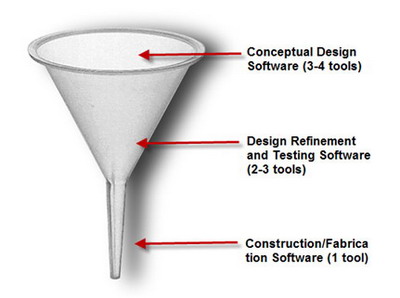CAD Management: The Funnel
I see many project teams made up of very talented people who have differing opinions on what software should be used for project delivery. They may desire to have software that they used at another firm, or maybe something they used in school. One team wants one thing and another team wants another. This can make the choices difficult and put you on a treadmill of software turnover as each team tries to reinvent the wheel.
I have taken a broad approach to software tools. If you can afford it and it gets the job done, why not use it? In a design arena, these tools are plentiful. There are tools that perform a wide range of varied tasks and tools that have a single special function. There may be software that is designed for one phase of a project and not another. There may be software that creates special geometry or analytics.
There are a lot of tools that must be used to get the job done, but how do you reign in all those tools as the project progresses?
My concept is to think of it like a funnel.
At the beginning of the project, you may want to allow the design team to use any and all tools that are available to them. As the project progresses and you enter another phase, you may start to limit those tools. As the project nears completion, design/construction or fabrication files need to be produced in a unified piece of software.
So as the team progresses, the large list of software is reduced, eventually, down to one software product that is used to create the final output.
Let’s take an architectural theme (only because that is my arena and I know the tools).

You start off with sketch paper and pencil and scribble out some initial ideas. You may use FormZ or Rhino or SketchUp at the early phases. Each team might have a talent or bent toward one of these tools. Early design concepts are worked out in whatever tool they want to use. They may also use tools to display the output of that phase. Early visualizations may be done in a combination of software renderings and Photoshop edits. PDF files are created. Image cutting and pasting is done into a PowerPoint presentation. You end up with randomly scattered tools being used to present a unified perception of the design. No one file format encapsulates the entire design.
Moving toward the beginning of Design Development and the refinement and testing of the design against constraints and codes, you move to something such as AutoCAD Architecture or the Revit tools. You are still using the original files for design interpretation, but you are now moving in the direction of a construction documentation effort.
Moving closer to the creation of the end product, hard copy or model, you again unify the efforts under one software tool. The original software that you used is no longer being used to document the design. You have narrowed the list as you near the bottom of the funnel – the final output.
So you may start out with a disjointed collection of tools that serve unique purposes and end up with one tool that documents the design. The final tool will be widely accepted by all team members, easy to exchange with others, and industry standard. This allows for flexibility at the beginning and unity at the end.